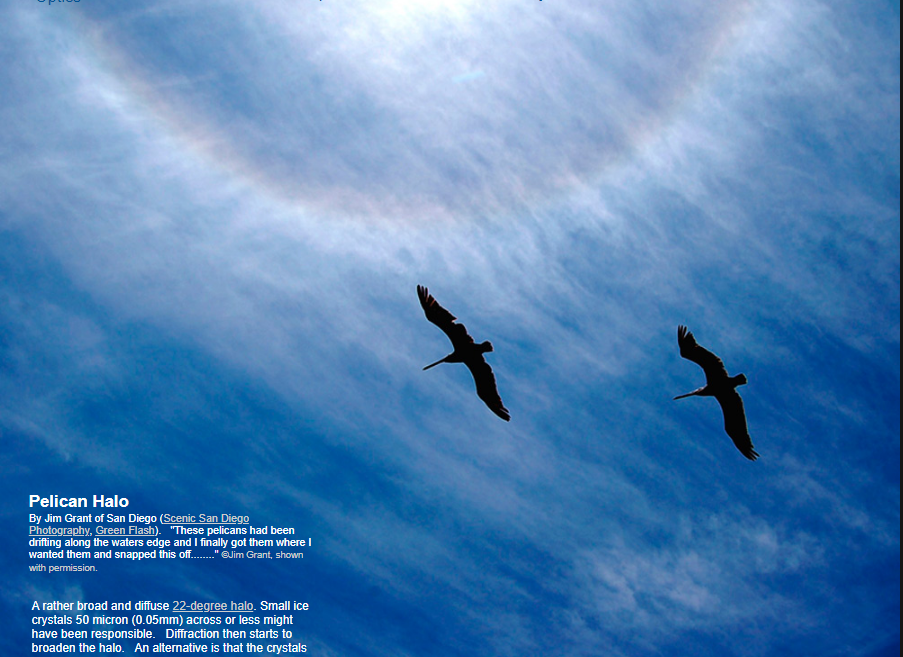Pelican Halo
Pelican Halo: Exploring the Phenomenon
Atmospheric optics never fails to amaze us with its captivating displays. One such spectacle is the Pelican Halo, a mesmerizing phenomenon that leaves onlookers in awe. In this article, we delve into the details of this intriguing atmospheric occurrence and uncover the science behind it.
The Pelican Halo is characterized by a rather broad and diffuse 22-degree halo. The halo appears as a circular ring around the sun or moon, encircling these celestial bodies with its ethereal glow. What causes this enchanting display? Let's explore the possibilities.
One theory suggests that small ice crystals, measuring 50 microns (0.05mm) across or less, play a role in creating the Pelican Halo. These tiny ice crystals, suspended in the atmosphere, act as natural prisms, bending and scattering light as it passes through them. As a result, the light undergoes diffraction, causing the halo to appear broader than usual.
Another explanation for the Pelican Halo involves the imperfections present on the surfaces of these ice crystals. It is possible that these crystals possess irregular shapes, trapped air bubbles, or other defects. These imperfections can further enhance the diffraction effect, contributing to the halo's diffuse appearance.
The Pelican Halo is not limited to a specific geographic location or time of year. It can occur in various regions around the world, provided the atmospheric conditions are suitable. This ethereal display often occurs in areas where there is a presence of high-altitude clouds containing ice crystals.
To witness the Pelican Halo firsthand, it is crucial to keep an eye on the sky when the sun or moon is partially covered by clouds. The diffraction of light through these ice crystals creates an optical phenomenon that transforms the sky into a mesmerizing canvas of light and color.
When observing the Pelican Halo, it's important to note that the phenomenon is not exclusive to pelican-shaped halos. The name "Pelican Halo" simply adds a touch of whimsy to this captivating atmospheric display. The halo itself appears as a circular ring, regardless of any association with pelicans.
In conclusion, the Pelican Halo is a captivating atmospheric optics phenomenon that showcases the beauty and complexity of nature. Whether caused by small ice crystals or imperfections on their surfaces, this diffuse halo adds a touch of magic to our skies. So, next time you find yourself gazing at the sun or moon partially hidden behind clouds, keep an eye out for the Pelican Halo and allow yourself to be enchanted by its ethereal presence.

Pelican Halo
By Jim Grant of San Diego (Scenic San Diego Photography, Green Flash). "These pelicans had been drifting along the waters edge and I finally got them where I wanted them and snapped this off........" ©Jim Grant, shown with permission.
A rather broad and diffuse 22-degree halo. Small ice crystals 50 micron (0.05mm) across or less might have been responsible. Diffraction then starts to broaden the halo. An alternative is that the crystals had imperfect faces, trapped air bubbles or other defects.
Note: this article has been automatically converted from the old site and may not appear as intended. You can find the original article here.
Reference Atmospheric Optics
If you use any of the definitions, information, or data presented on Atmospheric Optics, please copy the link or reference below to properly credit us as the reference source. Thank you!
-
<a href="https://atoptics.co.uk/blog/pelican-halo/">Pelican Halo</a>
-
"Pelican Halo". Atmospheric Optics. Accessed on November 25, 2024. https://atoptics.co.uk/blog/pelican-halo/.
-
"Pelican Halo". Atmospheric Optics, https://atoptics.co.uk/blog/pelican-halo/. Accessed 25 November, 2024
-
Pelican Halo. Atmospheric Optics. Retrieved from https://atoptics.co.uk/blog/pelican-halo/.